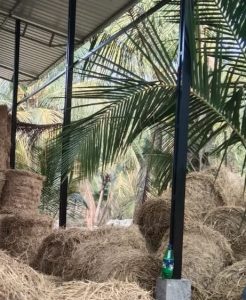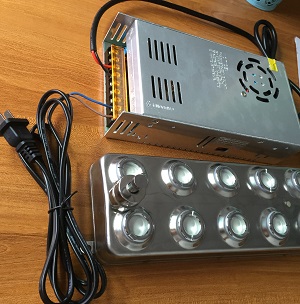
So, you want to start growing oyster mushrooms, and of course you are wondering how much money you need to invest in this project.
Table of Contents:
If you’ve ever searched the internet for a clear list of equipment and costs to grow oyster mushrooms — you’ve probably ended up frustrated. Unlike champignons or shiitake, oyster mushrooms don't come with a "standard farm setup." Why?
✅Oyster mushrooms can grow in a wide variety of climates.
What works well in a warm climate may not work in a cold climate. Furthermore, even in warm climates, growing methods vary depending on the humidity of the outside air.
✅There are too many methods being promoted online, from growing on windowsills to high-tech farms.
✅There’s no industry standard for growing volumes or room layouts.
Some farms, for example those growing champignons (button mushrooms), use standard equipment sets built for 20, 40, or 60 tons of substrate.
Regardless of your climate, standard mushroom growing equipment creates a certain temperature, humidity and air exchange rate.
But oyster mushroom growers? They start with anything — even an old garage or a basement.
Because of this, it's hard to create one-size-fits-all recommendations. But in this article, I’ll guide you through different types of growers and help you estimate costs realistically, based on your goals and your climate.
I divide growers into three main categories. Your startup costs will depend heavily on which group you fall into.
These are people who want to:

This group has the lowest costs. If your climate is mild, you may not need much equipment at all.
Many online teachers persistently promote the thesis that oyster mushrooms grow without any ventilation at all, and to create the necessary humidity it is enough to water the floor.
If it is constantly +18 or even 25 degrees Celsius outside your window, and the air humidity is 80%, this may be true - you do not need ventilation system - just open the windows opposite each other.
And indeed, you can simply water the floor. In general, if you are lucky enough to live in such a wonderful climate, feel free to start growing oyster mushrooms.
However, if you live in an area where temperature and humidity vary greatly from season to season, you will have to create conditions that are different from the natural conditions outside and suitable for oyster mushrooms.
You can grow mushrooms seasonally, in spring and autumn, to avoid heating or cooling costs. Or experiment with growing year-round and slowly add equipment.
These are people who want to grow mushrooms to sell, but not in large volumes yet.
If you aim for around 1 to 1.5 tons of mushrooms per month, you'll need more infrastructure — but it’s still manageable.
Two options here:
▶️Low substrate load per square meter: You need more space but spend less on climate control.
▶️High substrate load (120–140 kg/m²):
You save space, but need proper ventilation, humidity, and temperature control.
At this point, it makes sense to invest in:
At this scale, things get serious. You'll need:
If you’re growing at this volume without experience, I strongly recommend learning the basics first — or hiring someone with experience.
The ideal microclimate for oyster mushrooms requires:
📌How to determine if there is too much carbon dioxide read here.
But how much equipment you need depends on:
Here’s a basic equipment list for small-scale growers:
Equipment | Needed when |
Shelving (wood, metal, or plastic) | Always |
Axial exhaust fan (at least 100 m³/h per ton of substrate) | For better air exchange |
Ultrasonic humidifier or nozzles | When ambient humidity < 85% |
Heater (during incubation if room < 20°C / 68°F) (for fruiting if room < 12°C / 53°F) | Only in cold climates |
Cooler (for fruiting if room > 25°C / 77°F) | Only in hot climates |
Supply fan with ducts (250 m³/h per ton of substrate) | High substrate load (120–140 kg/m²) (245 to 285 lb per 10 ft²) |
❗️Important note: Growing oyster mushrooms in small spaces might not be practical if the outside temperature is too hot or too cold.
Why? Because it’s not the room air that needs to be heated or cooled — it’s the fresh air coming from outside. Without a steady supply of fresh air (and removal of excess CO₂), oyster mushrooms simply won’t grow.
How to calculate the power of exhaust fans?
For every ton of substrate, air exchange must be at least 100 cubic meters per hour.
For example, you have 50 bags of 10 kg each, which is 0.5 tons of substrate.

This means that a fan is needed at 50 cubic meters per hour. Plus another similar fan in case there are a lot of mushrooms at the same time.
To provide the necessary humidity, you need to buy an ultrasonic humidifier.
It should not be household, as they provide a humidity of no more than 60%.
It is best to buy ultrasonic plates and make a humidifier yourself.
You can also install one or two medium-pressure hydropneumatic nozzles near the windows.
Small drops of water will mix with the air flow, create the necessary humidity, and at the same time they will not drip onto the mushrooms.
You’ll need to upgrade when:
In that case, your shopping list will grow:
You’ll also need more power capacity, insulation, and possibly backup systems in case of power failure.
📌Read more about such ventilation here.
These systems are often the most expensive part of climate control for oyster mushrooms. That’s why it’s important to understand the potential costs early on, when planning your farm.
To get a rough estimate, start by multiplying the volume of your grow room by 6 — this represents the approximate air exchange rate per hour. Then look for a cooling unit that can handle that volume of air per hour. Do the same to find a heating unit with similar capacity.
If you have small growing volumes and no more than 8 tons of substrate in each cultivation chamber, you can buy my tables, where all the ventilation is calculated and the necessary equipment is described in detail.
If you're planning to grow over 1.5 tons of oyster mushrooms per month, you’ll need to take ventilation seriously. I offer a ventilation calculator specifically for commercial growers.
It includes:
- a detailed guide on setting up proper ventilation systems;
- an Excel spreadsheet where you can input your own parameters (block weight, number of rows, size of the grow room, number of ducts, etc.) and get exact airflow calculations.
📌Grow room ventilation calculator
If you're just starting out but want to reach commercial volumes from the beginning, I recommend my book “Mushroom Business from Scratch”. It's a complete guide for beginners and includes:
- an Excel planner to help estimate equipment costs and monthly expenses;
- tables that show how much space you need to grow between 1.5 and 6 tons of oyster mushrooms per month;
- explanations for each stage of the setup process, from scratch to scaling up.
The book is in Russian, but you can easily translate it using ChatGPT or a similar language model — they handle technical content very well.
📌You can find more information about the book here.
If you'd like to order the book or the calculator, feel free to reach out to me via email or whatsapp.
e-mail: [email protected]
WhatsApp: +380503960696
